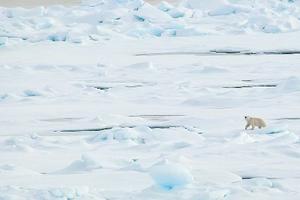Infrastructure protectionSea-level records reveal tight correlation between ice volume and polar temperature
During the last few million years, global ice-volume variability has been one of the main feedback mechanisms in climate change, because of the strong reflective properties of large ice sheets. Ice volume changes in ancient times can be reconstructed from sea-level records; a new study has revealed a rapid response between global temperature and ice volume/sea-level, which could lead to sea-levels rising by over one meter

Study shows lower temperatures yield more ice // Source: commons.wikimedia.org
A new study has revealed a rapid response between global temperature and ice volume/sea-level, which could lead to sea-levels rising by over one meter.
During the last few million years, global ice-volume variability has been one of the main feedback mechanisms in climate change, because of the strong reflective properties of large ice sheets. Ice volume changes in ancient times can be reconstructed from sea-level records. Detailed assessment of the role of ice volume in climate change, however, is hindered by inadequacies in sea-level records and their timescales.
A University of Southampton release reports that now, for the first time, scientists are able to accurately date continuous sea-level records, to allow detailed comparisons of the ice-volume variability with independently dated ice-core records from Antarctica and Greenland.
Previous studies of the timing of past ice-volume changes relied on the “Red Sea relative sea-level (RSL) record” for reconstruction of highly resolved and continuous records of sea-level variability over the past 500,000 years. The drawback of the RSL method, however, is that it did not have independent age control. This inhibited detailed comparison with other well-dated climate parameters, such as temperature or CO2 records from ice cores.
An international team of scientists, led by Eelco Rohling, Professor of Ocean and Climate Change at the University of Southampton, has developed a new method of dating the RSL record by using Mediterranean data from radiometric (Uranium-series) dating of cave deposits. This provided a much improved timescale for the RSL record. The team was able to apply the new dating method throughout the entire last glacial cycle (150,000 years), which resulted in an unprecedented continuous sea-level record with excellent independent age control.
The release notes that by comparing the ice-volume fluctuations with polar temperature reconstructions from the Greenland and Antarctica ice cores, the scientists found that changes in temperature and ice volume/sea level are closely coupled with a response time lag of only a few centuries. This timing relationship was previously unknown, and it reveals a very fast response between global temperature and ice volume/sea level.
The study also found that periods of extensive ice-volume reduction/sea-level rise were always characterized by very fast changes, of the order of one or even two meters per century sea-level rise.
Professor Rohling, who is currently based at the National Oceanography Center Southampton but will join the Australian National University next year, says: “This is the first time that these rates could be measured for any
